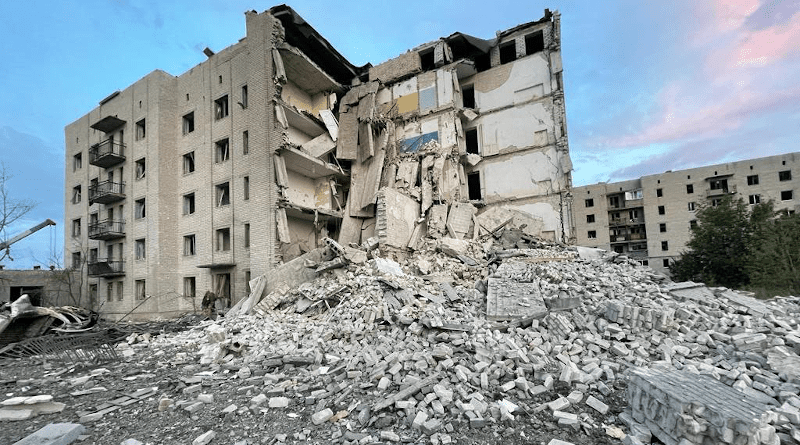Russians Launch Deadly Strike On Donetsk City As Fierce Fighting Rages In East
By RFE RL
(RFE/RL) — A Russian strike on a city in the eastern region of Donetsk killed at least three people on January 28 as Ukrainian forces engaged Russian troops in ferocious battles in several hot spots in the east, where Moscow has been pressing its offensive with increased urgency amid Western pledges of modern tank deliveries for Kyiv.
Ukrainian President Volodymyr Zelenskiy used the occasion to call on Western partners to supply his nation with long-range precision missiles, known as ATACMS, to reduce Russia’s ability to target cities.
“It would be possible to stop this Russian terror if we could source the appropriate missiles for our military forces,” Zelenskiy said in his nightly address on January 28.
A Russian strike on a residential neighborhood in the Donetsk city of Kostyantynivka killed three people and wounded at least two others, regional Governor Pavlo Kyrylenko said on Telegram.
Kyrylenko said four apartment buildings and a hotel had been damaged and that rescuers and police officials were at the site to “carefully document yet another crime by the Russian occupiers.”
Earlier on January 28, Kyrylenko said four people had been killed and at least seven wounded by Russian strikes in the last 24 hours.
The January 28 strikes were just the latest in a series by Russian forces to hit Ukrainian civilian targets as Moscow seemingly tries to use terror to weaken the nation’s resolve.
Mykhaylo Podolyak, a senior Zelenskiy aide, said in an interview on January 28 that Ukraine is engaged in “fast-track” talks on the possibility of acquiring ATACMs and jet fighters.
The United States has so far refrained from sending Ukraine either weapon for fear it would be perceived by Moscow as escalatory.
The ATACMs could strike Russian arms depots and other equipment up to 300 kilometers away, weakening Moscow’s ability to supply its troops at the front lines.
U.S. national-security spokesman John Kirby said on January 27 that the Biden administration does not have plans at the moment to send fighter jets to Ukraine.
Air support is a crucial element of a fighting strategy known as “combined arms” that also includes the use of artillery, tanks, armored fighting vehicles, and infantry.
The United States and its NATO allies earlier this month announced plans to send tanks, fighting vehicles, and more artillery to Ukraine as it prepares to launch a counteroffensive.
Meanwhile, the fighting on the front line remains extremely intense, especially in Donetsk, where major battles are under way for Vuhledar and Bakhmut, a town that has been virtually razed by repeated Russian artillery bombardments.
The General Staff of Ukraine’s Armed Forces said in its daily report early on January 28 that Russian troops continued to press on with a multipronged offensive in the eastern Ukrainian regions of Donetsk and Luhansk.
“The enemy continues to conduct offensive actions in the Bakhmut, Avdiyivka, and Novopavlivka directions,” the General Staff said.
“In the Kupyansk, Lyman, Zaporizhzhya, and Kherson directions, the enemy is on the defensive,” it said.
Ukrainian military spokesman Serhiy Cherevatiy told local media that “there is fierce combat” in Vuhledar.
“For many months, the military of the Russian Federation…has been trying to achieve significant success there,” he said.
Vuhledar, a town with a preinvasion population of around 15,000 people, has strategic significance as a communications node in southern Donetsk.
The secretary of Ukraine’s Security Council, Oleksiy Danilov, told RFE/RL that Moscow was preparing for a new offensive on February 24, the first anniversary of the Russian invasion.
“Now they are preparing for maximum activation…and they believe that by the anniversary they should have some achievements,” Danilov said. “There is no secret that they are preparing for a new wave by February 24, as they themselves say.”
Ukraine’s Western allies continue to pledge military equipment and aid to shore up Kyiv’s defenses.
U.S. national-security spokesman John Kirby said Washington anticipates an “intense period of fighting” in the coming months,” adding that there is “no sign” of the war stopping.
Zelenskiy said on January 27 that Ukraine needs up to 500 tanks.
“We need 300 or 500 tanks now. We need tanks to protect our territory, our land. We need armored vehicles to protect our people, that’s all,” Zelenskiy said in an interview with Sky News.
So far, a total of 321 heavy tanks have been promised to Ukraine by several countries, Ukraine’s ambassador to France, Vadym Omelchenko, said on BFM television on January 27, without giving further details.
The United States, Poland, Germany, and the United Kindom alone pledged more than 130 advanced tanks, with Spain, Finland, the Netherlands, and other countries expected to announce donations soon.
Russian forces in Ukraine have built hundreds of kilometers of field fortifications over the past few months. Breaking through those lines will require tanks in a coordinated attack with other weapon systems to punch through those defenses.
EU Commission President Ursula von der Leyen also reassured Ukraine of the bloc’s unconditional support. Speaking in the German city of Duesseldorf on January 28, von der Leyen said, “We stand by Ukraine’s side without any ifs and buts.”
Von der Leyen and her fellow EU commissioners plan an EU-Ukraine summit on February 3.
The Kremlin has reacted with fury to the latest gestures of Western solidarity with Ukraine and said it saw the promised delivery of advanced tanks as evidence of escalating “direct involvement” of the United States and NATO in Russia’s war of aggression, something both deny.
In a separate development, Ukraine said it would summon Hungary’s ambassador to complain about “completely unacceptable” remarks Prime Minister Viktor Orban made about Ukraine, Kyiv said on January 27.
Ukrainian Foreign Ministry spokesman Oleh Nykolenko said Orban had told the media that Ukraine was a no-man’s-land and compared it to Afghanistan.

